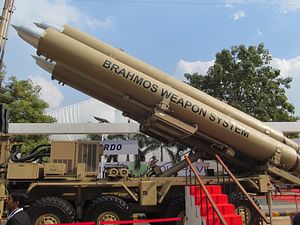The Indian Ministry of Defense’s research arm, the Defense Research Development Organization (DRDO), and the Indian Army have test fired a supersonic BrahMos cruise missile under “extreme weather conditions” on July 16, the Indian defense minister, Nirmala Sitharaman, said in a statement today.
The test launch of the BrahMos surface-to-surface cruise missile took place at 10:17 a.m. local time today at a test range in Balasore district in the eastern Indian state of Odisha. “The test was under extreme weather conditions with sea-state 7 (waves as high as 9 m),” the Indian defense minister tweeted earlier today.
The BrahMos, fired from a static inclined launcher, flew in its pre-set trajectory meeting its mission objectives, according to DRDO. “The missile was tested as part of the service life extension program for the Indian Army,” Sitharam added. “This successful [DRDO] trial validates the extension and reinforces the all-weather capabilities of the BrahMos missile.”
The July 16 launch tested new locally designed components of the BrahMos developed for some of the cruise missile’s subsystems to extend the weapon’s service life from 10 to 15 years. It was the fourth test launch to verify indigenous components of the BrahMos this year. Previous tests occurred on March 22, May 22 and May 24. As I explained in May:
India has made a concerted effort over the last few years to incrementally indigenize the various components and subsystems of the BrahMos missile, a joint venture between India’s DRDO and Russian rocket design bureau NPO Mashinostroyeniya, amid a souring of India-Russia defense relations and the cancellation of a number of joint defense projects.
In March, a ground-launched BrahMos equipped with an indigenous seeker — developed by BrahMos Aerospace and DRDO, and manufactured by state-owned Electronics Corporation of India — was successfully tested for the first time. Russia still supplies the missile’s ramjet propulsion system and seeker technology (for now), while India provides the inertial navigation system and fire control system.
DRDO is also working on an indigenous missile booster for the BrahMos. The missile — named after the Brahmaputra River in India and the Moskva River in Russia – is a derivative of the Russian-made P-800 Oniks over-the-horizon supersonic anti-ship cruise missile.
The missile’s range is estimated at around 300 to 400 kilometers. Capable of reaching top speeds of up to Mach 2.8 to 3, the BrahMos is considered one of the the world’s fastest cruise missile currently in operational use.
The land-launched and sea-launched variants of the BrahMos are already in service with the Indian Army and Navy. An air-launched variant is expected to become operational by the end of 2018 with the Indian Air Force, although that date is likely to be pushed to 2019.
In a push to speed up mass production of the new missile, Indian defense firm and BrahMos manufacturer Larsen & Toubro inaugurated a new production line for BrahMos transport launch canisters in Vadodara in the western state of Gujarat, India earlier this month.
































